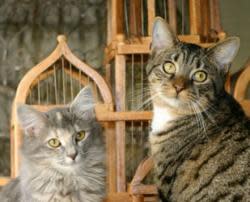Why Do Cats Purr?

Have you ever wondered about the little motorboat inside your cat? My friend noticed that his cat purrs when he is stroked and has always wondered why and how he does it. He always thought of it as a sign of contentment, but I informed him of the scientific theories that attempt to explain this feline phenomenon.
What Is a Purr?
Purring is a sound and vibration cats make by moving the muscles in their throat and diaphragm. I describe the sound and vibration as a motorboat inside the cat. It is low in volume, and you can best feel the vibration by placing your hand on the cat's back or stomach. There is no unique internal organ that produces the sound.
Why Do They Do It?
There is no definite or specific answer for purring in cats. I know when I stroke my cat he purrs, so I see this as a sign of contentment or relaxation. Some scientists believe purring is also a social or healing function.
One part of their theory states that purring triggers the brain to release a chemical that eases pain, and this could be why some cats have been found to purr while in labor. Other cats purr when eating, sleeping or when in pain. It could also be seen as a request for food and may vary in pitch and volume.
Related: Why Do Cats Knead on People?
Some cats also purr when at the veterinarian or when in distress. This may be a sign of discomfort or a way to signal that they are not a threat to anyone. Cats can purr when inhaling and exhaling. Kittens are rumored to purr as a way to signal the mother that they are OK or receiving enough milk when feeding.
The Scientific American offers another explanation: Cats purr as a way to stimulate bones and muscles without using a lot of energy. Cats do not have as many bone abnormalities or problems as other animals, and their purring may be one contributing factor to this phenomenon.
How Loud Can It Get?
The average cat purr registers around 25 decibels but can be much louder. The volume and frequency can be much lower or higher depending on the species (domestic cat, cheetah, etc.). Cats in the wild do not purr as much as or similar to domestic cats, and most of their purring occurs when exhaling.
There is one cat striving for a world record in purring. British cat Smokey's purr registers at 80 decibels and can register up to 92 decibels when registered up close. The volume is as loud as a hair dryer or lawnmower, and the owner complains that it drowns out movie scenes and telephone conversations. That's one loud kitty!
It's Not Just for the Kitties
An interesting theory was presented by Benjamin L. Hart, DVM, PhD, distinguished professor emeritus at the University of California, Davis, School of Veterinary Medicine. Dr. Hart explains that cats that purr cannot roar, and cats that roar cannot purr. Other animals have been found to purr or make similar sounds and vibrations. Hyenas, raccoons, guinea pigs and even mongooses are reportedly fellow motorboats to the furry felines.
Check out more from WebVet and PetsAdviser!
Why Do Cats Hate Water?
How Do Dogs Hear So Well?
Dog Microchips - How Do They Work?
